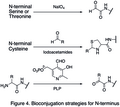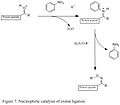Bioconjugation
Bioconjugation
Bioconjugation is a chemical strategy used to form a stable covalent link between two molecules, one of which is typically a biomolecule. This process is crucial in the development of various biotechnological and therapeutic applications, including the creation of antibody-drug conjugates, biosensors, and imaging agents.
Overview[edit]
Bioconjugation involves the attachment of a biomolecule, such as a protein, nucleic acid, or carbohydrate, to another molecule, which can be a small synthetic compound, another biomolecule, or a nanoparticle. The goal is to combine the unique properties of each component to create a new entity with enhanced or novel functionalities.
Techniques[edit]
Several techniques are employed in bioconjugation, each with its own advantages and limitations. Some of the most common methods include:
Amide Bond Formation[edit]
Amide bond formation is one of the most widely used bioconjugation techniques. It involves the reaction between a carboxylic acid group and an amine group to form an amide bond. This method is often used to attach peptides to other molecules.
Click Chemistry[edit]
Click chemistry is a class of bioconjugation reactions that are highly efficient, selective, and occur under mild conditions. The most popular click chemistry reaction is the copper-catalyzed azide-alkyne cycloaddition (CuAAC), which forms a stable triazole linkage.
Thiol-Maleimide Reaction[edit]
The thiol-maleimide reaction is a specific and efficient method for conjugating molecules containing thiol groups, such as cysteine residues in proteins, to maleimide-functionalized compounds.
Enzymatic Conjugation[edit]
Enzymatic methods utilize enzymes to catalyze the formation of covalent bonds between biomolecules. These methods are often highly specific and can occur under physiological conditions.
Applications[edit]
Bioconjugation has a wide range of applications in various fields:
Therapeutics[edit]
In therapeutics, bioconjugation is used to create antibody-drug conjugates (ADCs), which are designed to deliver cytotoxic drugs specifically to cancer cells, minimizing damage to healthy tissues.
Diagnostics[edit]
Bioconjugation is employed in the development of biosensors and diagnostic assays, where biomolecules are conjugated to reporter molecules to detect specific analytes.
Imaging[edit]
In medical imaging, bioconjugation is used to attach imaging agents to targeting molecules, allowing for the visualization of specific tissues or disease sites.
Challenges[edit]
Despite its many applications, bioconjugation faces several challenges, including:
- Specificity: Achieving selective conjugation without affecting the biological activity of the biomolecule.
- Stability: Ensuring the stability of the conjugate under physiological conditions.
- Scalability: Developing methods that are scalable for industrial applications.
Also see[edit]
| Biotechnology | ||||||||||
|---|---|---|---|---|---|---|---|---|---|---|
|
| Branches of chemistry | ||||||||||
|---|---|---|---|---|---|---|---|---|---|---|
|
-
Ibritumomab tiuxetan structure
-
Bioconjugation strategies for lysine residues
-
Bioconjugation strategies for cysteine residues
-
Bioconjugation strategies for tyrosine residues
-
Bioconjugation strategies for N-terminus
-
Bioconjugation strategies for C-terminus
-
Bioconjugation strategies for targeting ketones and aldehydes
-
Nucleophilic catalysis of oxime ligation
Ad. Transform your life with W8MD's Budget GLP-1 injections from $75


W8MD offers a medical weight loss program to lose weight in Philadelphia. Our physician-supervised medical weight loss provides:
- Weight loss injections in NYC (generic and brand names):
- Zepbound / Mounjaro, Wegovy / Ozempic, Saxenda
- Most insurances accepted or discounted self-pay rates. We will obtain insurance prior authorizations if needed.
- Generic GLP1 weight loss injections from $75 for the starting dose.
- Also offer prescription weight loss medications including Phentermine, Qsymia, Diethylpropion, Contrave etc.
NYC weight loss doctor appointmentsNYC weight loss doctor appointments
Start your NYC weight loss journey today at our NYC medical weight loss and Philadelphia medical weight loss clinics.
- Call 718-946-5500 to lose weight in NYC or for medical weight loss in Philadelphia 215-676-2334.
- Tags:NYC medical weight loss, Philadelphia lose weight Zepbound NYC, Budget GLP1 weight loss injections, Wegovy Philadelphia, Wegovy NYC, Philadelphia medical weight loss, Brookly weight loss and Wegovy NYC
|
WikiMD's Wellness Encyclopedia |
| Let Food Be Thy Medicine Medicine Thy Food - Hippocrates |
Medical Disclaimer: WikiMD is not a substitute for professional medical advice. The information on WikiMD is provided as an information resource only, may be incorrect, outdated or misleading, and is not to be used or relied on for any diagnostic or treatment purposes. Please consult your health care provider before making any healthcare decisions or for guidance about a specific medical condition. WikiMD expressly disclaims responsibility, and shall have no liability, for any damages, loss, injury, or liability whatsoever suffered as a result of your reliance on the information contained in this site. By visiting this site you agree to the foregoing terms and conditions, which may from time to time be changed or supplemented by WikiMD. If you do not agree to the foregoing terms and conditions, you should not enter or use this site. See full disclaimer.
Credits:Most images are courtesy of Wikimedia commons, and templates, categories Wikipedia, licensed under CC BY SA or similar.
Translate this page: - East Asian
中文,
日本,
한국어,
South Asian
हिन्दी,
தமிழ்,
తెలుగు,
Urdu,
ಕನ್ನಡ,
Southeast Asian
Indonesian,
Vietnamese,
Thai,
မြန်မာဘာသာ,
বাংলা
European
español,
Deutsch,
français,
Greek,
português do Brasil,
polski,
română,
русский,
Nederlands,
norsk,
svenska,
suomi,
Italian
Middle Eastern & African
عربى,
Turkish,
Persian,
Hebrew,
Afrikaans,
isiZulu,
Kiswahili,
Other
Bulgarian,
Hungarian,
Czech,
Swedish,
മലയാളം,
मराठी,
ਪੰਜਾਬੀ,
ગુજરાતી,
Portuguese,
Ukrainian






